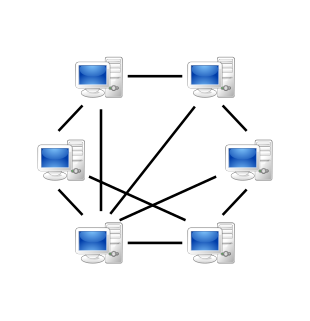Distributed computing is a field of computer science that studies distributed systems. A distributed system is a system whose components are located on different networked computers, which communicate and coordinate their actions by passing messages to one another. The components interact with one another in order to achieve a common goal. Three significant characteristics of distributed systems are: concurrency of components, lack of a global clock, and independent failure of components. Examples of distributed systems vary from SOA-based systems to massively multiplayer online games to peer-to-peer applications.

Freenet is a peer-to-peer platform for censorship-resistant communication. It uses a decentralized distributed data store to keep and deliver information, and has a suite of free software for publishing and communicating on the Web without fear of censorship. Both Freenet and some of its associated tools were originally designed by Ian Clarke, who defined Freenet's goal as providing freedom of speech on the Internet with strong anonymity protection.

Peer-to-peer (P2P) computing or networking is a distributed application architecture that partitions tasks or workloads between peers. Peers are equally privileged, equipotent participants in the application. They are said to form a peer-to-peer network of nodes.
The Semantic Web is an extension of the World Wide Web through standards by the World Wide Web Consortium (W3C). The standards promote common data formats and exchange protocols on the Web, most fundamentally the Resource Description Framework (RDF). According to the W3C, "The Semantic Web provides a common framework that allows data to be shared and reused across application, enterprise, and community boundaries". The Semantic Web is therefore regarded as an integrator across different content, information applications and systems.
Grid computing is the use of widely distributed computer resources to reach a common goal. The grid can be thought of as a distributed system with non-interactive workloads that involve a large number of files. Grid computing is distinguished from conventional high-performance computing systems such as cluster computing in that grid computers have each node set to perform a different task/application. Grid computers also tend to be more heterogeneous and geographically dispersed than cluster computers. Although a single grid can be dedicated to a particular application, commonly a grid is used for a variety of purposes. Grids are often constructed with general-purpose grid middleware software libraries. Grid sizes can be quite large.

A Beowulf cluster is a computer cluster of what are normally identical, commodity-grade computers networked into a small local area network with libraries and programs installed which allow processing to be shared among them. The result is a high-performance parallel computing cluster from inexpensive personal computer hardware.
MOSIX is a proprietary distributed operating system. Although early versions were based on older UNIX systems, since 1999 it focuses on Linux clusters and grids. In a MOSIX cluster/grid there is no need to modify or to link applications with any library, to copy files or login to remote nodes, or even to assign processes to different nodes – it is all done automatically, like in an SMP.
In psychology and sociology, a trust metric is a measurement of the degree to which one social actor trusts another social actor. Trust metrics may be abstracted in a manner that can be implemented on computers, making them of interest for the study and engineering of virtual communities, such as Friendster and LiveJournal.
In computer networking davfs2 is a Linux tool for connecting to WebDAV shares as though they were local disks. It is an open-source GPL-licensed file system for mounting WebDAV servers. For communicating with the kernel, davfs2 can either use the FUSE file system API, or the Coda network file system protocol over sockets. davfs2 uses the neon WebDAV library for communicating with the web server.
Grid MP is a commercial distributed computing software package developed and sold by Univa, a privately held company based primarily in Austin, Texas. It was formerly known as the MetaProcessor prior to the release of version 4.0, however the letters MP in Grid MP do not officially stand for anything.

Geographic routing is a routing principle that relies on geographic position information. It is mainly proposed for wireless networks and based on the idea that the source sends a message to the geographic location of the destination instead of using the network address. The idea of using position information for routing was first proposed in the 1980s in the area of packet radio networks and interconnection networks. Geographic routing requires that each node can determine its own location and that the source is aware of the location of the destination. With this information a message can be routed to the destination without knowledge of the network topology or a prior route discovery.
Distributed networking is a distributed computing network system where components of the program and data depend on multiple sources.
A gossip protocol is a procedure or process of computer peer-to-peer communication that is based on the way that epidemics spread. Some distributed systems use peer-to-peer gossip to ensure that data is routed to all members of an ad-hoc network. Some ad-hoc networks have no central registry and the only way to spread common data is to rely to each member to pass it along to their neighbors.
Ubiquitous robot is a term used in an analogous way to ubiquitous computing. Software useful for "integrating robotic technologies with technologies from the fields of ubiquitous and pervasive computing, sensor networks, and ambient intelligence".

oVirt is a free, open-source virtualization management platform. It was founded by Red Hat as a community project on which Red Hat Enterprise Virtualization is based. It allows centralized management of virtual machines, compute, storage and networking resources, from an easy-to-use web-based front-end with platform independent access. KVM on x86-64 and PPC architecture are the only hypervisors supported, but there is an ongoing effort to support ARM architecture in the future releases.

A computer cluster is a set of loosely or tightly connected computers that work together so that, in many respects, they can be viewed as a single system. Unlike grid computers, computer clusters have each node set to perform the same task, controlled and scheduled by software.
ServerNet is a switched fabric communications link primarily used in proprietary computers made by Tandem Computers, Compaq, and HP.
Smart-M3 is a name of an open-source software project that aims to provide a Semantic Web information sharing infrastructure between software entities and devices. It combines the ideas of distributed, networked systems and semantic web. The ultimate goal is to enable smart environments and linking of real and virtual worlds.
Tahoe-LAFS is a free and open, secure, decentralized, fault-tolerant, distributed data store and distributed file system. It can be used as an online backup system, or to serve as a file or Web host similar to Freenet, depending on the front-end used to insert and access files in the Tahoe system. Tahoe can also be used in a RAID-like fashion using multiple disks to make a single large Redundant Array of Inexpensive Nodes (RAIN) pool of reliable data storage.

A data grid is an architecture or set of services that gives individuals or groups of users the ability to access, modify and transfer extremely large amounts of geographically distributed data for research purposes. Data grids make this possible through a host of middleware applications and services that pull together data and resources from multiple administrative domains and then present it to users upon request. The data in a data grid can be located at a single site or multiple sites where each site can be its own administrative domain governed by a set of security restrictions as to who may access the data. Likewise, multiple replicas of the data may be distributed throughout the grid outside their original administrative domain and the security restrictions placed on the original data for who may access it must be equally applied to the replicas. Specifically developed data grid middleware is what handles the integration between users and the data they request by controlling access while making it available as efficiently as possible. The adjacent diagram depicts a high level view of a data grid.







